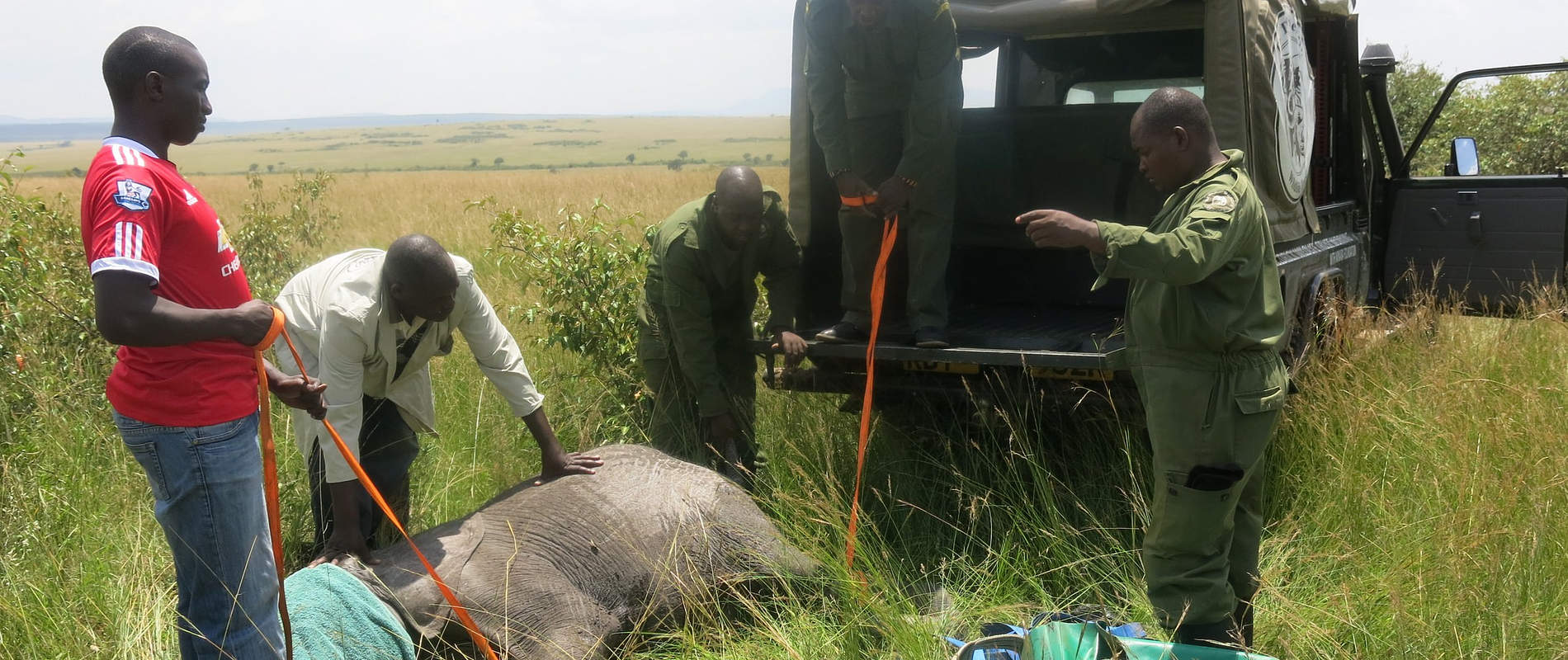FIELD VETERINARY REPORT FOR MASAI MARA FEBRUARY -2016 By Dr
FIELD VETERINARY REPORT FOR MASAI MARA FEBRUARY -2016
By Dr. Campaign K.Limo
Introduction
The month was characterised by sporadic showers which later gave way to dry and hot conditions. There is still plenty of food including water for most animals to access.
Elephant collaring which started the previous month continued with an additional three elephants collared during the month. Other activities took place, including ear notching and fitting of transmitters to the rhino population in the Mara among others.
The following are activities that were undertaken by the unit during the month;
CASE#1 ELEPHANT COLLARING EXERCISE
Date: 1st – 3rd February 2016
Species: Elephant
Sex: Mixed
Age: Adult
Location; MMNR
History
In total ten elephants have been earmarked to be collared in the Masai Mara Ecosystem. Five were collared in January and a further three collared in February. This exercise is a collaborative effort between KWS, WWF and Narok County Government, where elephant candidates within the ecosystem were identified and fitted with GSM collars for both research and monitoring for security. All individuals collared were adults; with female matriarchs, second in command females or mature bulls identified as candidates. These were considered to represent respective herds hence their movements represent the movement of the entire herd and can be easily tracked. In addition to collaring morphometric measurements of candidates were taken, blood for haematology and tissue for DNA were also collected. Soundness of elephants were also confirmed and any injuries treated.
CASE#2 ELEPHANT DEATHS IN MMNR SURROUNDING CONSERVANCIES
These mysterious deaths occurred between 1st Feb and 6th Feb with a total of 6 elephants dying as follows;
- On 1st Feb one naturally tusk-less female died in Naboisho at GPS 36M0752622 UTM 9846168
- On 3rd Feb a big male was found dead in Mara North Conservancy at GPS 36M0739690 UTM 9858081, tusks were intact
- On 4th Feb, two carcasses of a male and a female at GPS36 M 0761699, UTM9843546 and 36M0753944, UTM 9843546 respectively were found in Naboisho conservancy. Tusks were intact
- On 6th Feb, a decomposed carcass of a male elephant was found in Olare Orok at GPS 36M0751267 and UTM 9851783 with tusks intact
- On 6th Feb 2016 a severely sick elephant bull at Mara North Conservancy was examined. As he was recumbent and unable to respond to several stimuli, he was euthanized and sampled. Tusks were recovered and handed to KWS security team that was present. This was at GPS location 36M0741261, UTM9867746
All these elephants died within a radius of 8km and in a period of one week. Except for the last case which was euthanized, none of the others were seen or reported sick.
General examination revealed they were all in good body condition prior to death and gross post mortem examination did not reveal any unusual findings in their systems.
This was considered an acute or per acute condition and highly notifiable diseases like anthrax had to be ruled out as this is also zoonotic and risk to humans. Samples collected from the initial carcasses and sent to Government Veterinary Investigation Laboratory in Nakuru as a matter of urgency turned negative for anthrax.
Stomach contents and blood were collected from the other carcasses for toxicological analysis. These were sent to the Government chemist for analysis. The results are still being awaited. Meanwhile no more similar deaths have been reported so far.
CASE#3 POST MORTEM OF A POACHED RHINO
Date: 7th Feb 2016
Species: Black rhino
Sex: Male
Age: Adult (33-38yrs)
Location; MMNR
History
In the midst of the ear notching process, a carcass of a black rhino was seen close to Kenya/Tanzania border which appeared relatively fresh and had both horns missing. A post mortem to establish cause of death was then conducted.


General observation
- This rhino was found lying on his left position with part of his ears chopped off. He appeared to have been in good body condition before death.
- Both horns had been removed by crude hacking and cranial part of his lower jaw hacked off.
- On flipping the rhino carcass over, a piercing wound was seen to his left flank which accessed the gastro intestinal tract with ingesta seeping out
- There were signs of stumbling and slight struggle before death at the scene
- Spear head was recovered from the wound having damaged internal organs
On opening the carcass, the damage by the spear was evident and involved the gastro intestinal system
The spear head was recovered and handed over to the investigating team.
Cause of Death
This rhino died as a result of fatal injuries inflicted by spearing with a clear motive of poaching.
CASE#4 RESCUE OF AN ELEPHANT CALF
Date: 7th Feb 2016
Species; African elephant
Sex: Female
Age: 2 years
Location: MMNR
History
This young calf was seen hanging around Simba Lodge in MMNR alone. An attempt to trace her mother was fruitless as all elephant herds passing by showed no interest in her. She kept wandering around on her own and a day before being rescued she disappeared only to be found the next day alone in the reserve.
Rescue
She was in fairly good condition and had to be chemically restrained with 50mgs Azaperone before being physically captured.
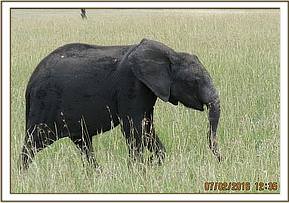

Examination after capture showed she had not sustained any injuries as was in good health. She was roped and placed on a pickup truck enroute to Keekorok airstrip where she was flown to DSWT elephant orphanage in Nairobi for fostering and better care.
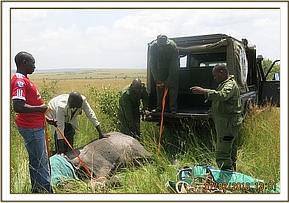

CASE#5 BLACK RHINO EAR-NOTCHING AND TRANSMITTER FITTING EXERCISE
This exercise was carried out by KWS in conjunction with WWF and Narok County Government. This was done with capture team from KWS headquarters and took place between 3rd February 2016 and 17th February 2016.
The aim of the exercise was to ear-notch all clean rhinos and enhance notches for those already notched while transmitters and transponders were being fitted. All these activities are meant to assist in monitoring of this endangered species. A good number of candidates were found between the Kenya and Tanzania border.
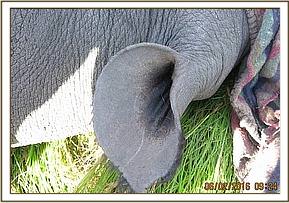

Fitting of transponders also help in positive identification of rhino carcasses as was applied in the carcass found during the exercise. Scanning revealed the identity of this rhino.
A total of 25 black rhinos were worked on during the exercise and 41 individuals seen in total. Blood was collected for haematology and tissue samples were taken for DNA analysis and banking.
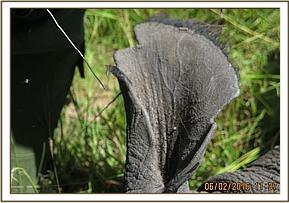

The exercise went on successfully.
CASE#6 POST MORTEM OF A YOUNG ELEPHANT BULL
Date: 19th Feb 2016
Species; African elephant
Sex: Male
Age: Sub-Adult (approx. 10 years old)
Location: Musiara (MMNR)
History
This young elephant bull was found dead at a marsh in the Musiara sector of Masai Mara National Reserve (MMNR) on the morning of 19th February 2016.The same information was relayed to the Vet Unit by both The Senior Warden Narok station and the Chief Park Warden MMNR.
Having lost a few elephants in the recent past whose causes of death are still under investigation, it was imperative that a thorough post mortem be conducted to confirm if this could be another death from a related condition.
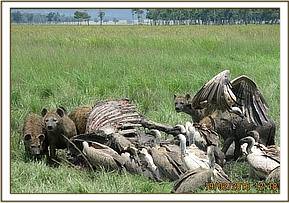

We found the carcass pulled out of the marsh where apparently it had submerged upon death. The tusks were already recovered by MMNR security team for accounting and safe custody.
Some information provided indicated that this bull had been seen the previous day around 6.30PM severely emaciated, lethargic and struggling to mud bathe. However he died at night before any reports for attention had been made.
General Examination
- This carcass had been badly scavenged upon by hyenas and vultures to the extent that no meaningful post mortem could be performed
- However the head and the limbs were partly intact with clear indication that this elephant was emaciated and dehydrated before death. An indication that he suffered a chronic debilitating condition to which he succumbed
- The mucus membranes were very pale with the tongue almost white a clear indication that he was anaemic. Getting blood smears was even difficult because of severe anaemia
- Gastro intestinal system had been ripped open and scavenged on by vultures hence nothing recoverable from the system was possible
- There was evidence of multiple joint swellings of the limbs suggestive of polyarthritis. Opening of these joints confirmed this as purulent stuff was found in the joints
- Combined with history, this elephant had suffered a slow debilitating condition whose presentations included anaemia and poly arthritis which was grossly discernible
Cause of Death
- From the findings and location, the cause of death for this particular case is different from the previously reported cases. This was a long standing debilitating condition and this should be treated as an isolated case
- For the past eight days, no new cases of unexplained sudden elephant deaths within Mara have been reported
- Polyarthritis; this condition could as well have caused damage to blood producing organs or could have caused great blood cell destruction to result in severe anaemia. It is unfortunate the internal organs, viscera could not be recovered for examination but chances are there could have been polyserositis as this in most cases accompany polyarthritis. There could have been damage to other internal organs especially viscera as well.
- Nevertheless impression smears were collected and submitted to our diagnostic lab for microscopic examination. Results from our laboratory and from Government’s Central veterinary Laboratory were negative for anthrax bacilli.
CASE#7 TREATMENT OF A YOUNG ELEPHANT BULL
Date: 23rd February 2016
Species; African elephant
Sex: Male
Age: Juvenile (4 – 5 years old)
Location: KWS research station
History
This young bull, in the company of an older bull, was seen near the research station limping on his left hind leg. After drinking water in a nearby stream, he spent time under a shady tree. He moved with a lot of difficulty and there was evidence of pain on the affected limb. No wound could be seen from a distance but there was evidence of pain when he attempted to move.
Immobilization, examination and treatment
Immobilization was achieved by use of 5mg Etorphine hydrochloride delivered through a 3ml Dan-inject dart from foot. It took eight minutes for the drugs to take full effect with this young elephant going down on his right side.
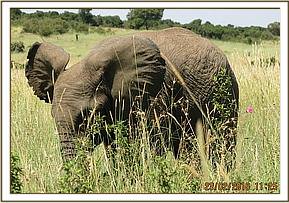

Examination revealed no external wound but slight swelling of the left tarsal joint. This could have resulted from a dislocation. Treatment involved use of 100mgs Flunixin meglumine anti-inflammatory and 3000mgs Amoxicillin antibiotic all given by intramuscular route.
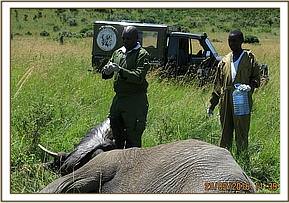

Reversal
Reversal of the anaesthetic was achieved by administration of 18mgs Diprenorphine hydrochloride through a superficial ear vein. He rose up in four minutes to join the older bull.
Prognosis
Good.
CASE#8 POSTMORTEM OF TWO DEAD BLACK RHINOS IN MASAI MARA
Date: 26th February 2016
Species: Black Rhino
Sex: Female
Age: Adult female and her 7month old calf
Location: MMNR (Sand River)
History
Reports were made to the Mobile Veterinary Unit by the Chief Park Warden MMNR that a carcass of a female rhino and that of her calf were found near Sand River being fed on by a pride of lions. Initial thoughts were that the pride had killed the two. The Vet Unit responded to carry out a post mortem and establish the cause of their deaths.
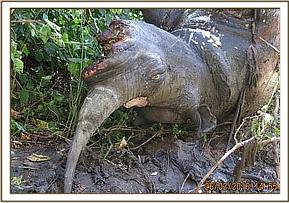

General examination
- Both carcasses were in close proximity less than five metres from one another
- Maggots had begun infesting on the adult female rhino carcass which appeared older than that of the calf with putrefaction setting in. The mother could have died three days ago with the calf dying twenty four hours later
- The calf appeared fresh and bite marks from a lion were evident on the lateral surfaces of her nostrils and neck. Her only rostral horn was intact
- Both appeared to have been in good condition prior to death
- For the mother, she appeared to have struggled up a bushy steep bank before dying. Both her horns were intact
- Both the mother and the calf had no ear notches
- No external injuries were evident on both carcases except those caused by predators
- The calf was considered to have been killed by lions hours after the death of her mother whilst she loitered around her dead mother. The bite marks close to her nostrils and neck was a clear indication she was suffocated by the predators. Her abdomen had been punctured and internal organs fed on by lions.
On opening the adult female the following findings were noted;
- The liver, lungs, spleen and the kidneys were beginning to autolyse
- The heart appeared flaccid though with sound architecture
- Both small and large intestines were filled with gas, ballooning and retro placed
- The terminal colon was displaced anteriorly with scanty faecal matter evident
- There was also evidence of intestinal torsion with intestinal haemorrhages noted
- No other abnormality was detected in the carcass
Cause of Death
The mother rhino could have died due to complications associated with intestinal torsion. The calf was killed by lions after the death of her mother. All horns were retrieved and handed over to MMNR security team for accounting and safe custody.
Acknowledgements
The Mara Mobile Veterinary unit would like to thank all those who contributed to the success of their work during the month. Thanks to the Minara Foundation through DSWT for their facilitation to the unit. Thanks to KWS for their continued technical support. Without all of you, working to save wildlife in this ecosystem would not be possible.
